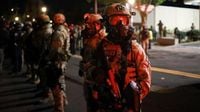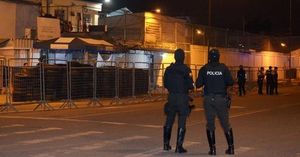In a whirlwind series of legal and political maneuvers, a Trump-appointed federal judge in Oregon has temporarily blocked the Trump administration from deploying National Guard troops from any state into Portland, Oregon. The late-night ruling, handed down by U.S. District Judge Karin Immergut on October 5, 2025, marked the second time in as many days that the court rebuffed President Donald Trump’s efforts to send federalized military forces to quell ongoing protests at a local Immigration and Customs Enforcement (ICE) facility.
The drama began on Saturday, October 4, when Judge Immergut first barred the administration from using Oregon’s own National Guard for crowd control in Portland. That order was swiftly met with a fresh attempt by the White House to reassign National Guard units from California and Texas to the city. But as the Associated Press reported, this apparent end-run around the court’s initial ruling prompted a hastily scheduled emergency hearing Sunday night, where Immergut expanded the block to cover Guard troops from all 50 states and Washington, D.C.
“How could bringing in federalized National Guard from California not be in direct contravention to the temporary restraining order I issued yesterday?” Judge Immergut asked, pointedly interrupting the federal government’s attorney. According to CNN, she pressed Deputy Assistant Attorney General Eric Hamilton on whether the administration was simply circumventing her order, adding, “Aren’t defendants simply circumventing my order?”
The judge’s frustration was palpable as she grilled the Justice Department’s legal team. Her initial order had rested on the determination that the president appeared to have “exceeded his constitutional authority” by federalizing troops, as the Portland protests did not pose a “danger of rebellion.” Conditions in the city, she noted, had not changed between the two rulings.
Local and state officials have long disputed the White House’s characterization of Portland. President Trump has described the city as “war ravaged,” a “war zone,” and “burning down,” likening it to “living in hell.” Yet, as the Associated Press pointed out, the protests have been largely confined to a single city block far from downtown in a city spanning 145 square miles. Many of the president’s claims, officials say, seem to rely on images from 2020, when protests following the Black Lives Matter movement did lead to months of unrest.
Since Trump’s second term began in January 2025, small protests have persisted outside the ICE facility, occasionally flaring into larger gatherings. The most recent escalation came after the Trump administration mobilized the Oregon National Guard on September 28, 2025, over the objections of Governor Tina Kotek. That move, according to court filings, spurred increased protest activity, culminating in a crowd of about 400 people outside the ICE facility on October 4. Federal agents responded by firing tear gas canisters into the crowd.
As the legal battle heated up, the Pentagon confirmed that about 200 California National Guard members who had been on duty in Los Angeles were reassigned to Portland. By early October 5, roughly 100 California Guard troops had landed in the city, with another 100 arriving by evening, according to Brigadier General Alan Gronewold, commander of Oregon’s National Guard. Meanwhile, a memo from Defense Secretary Pete Hegseth ordered up to 400 Texas National Guard personnel activated for deployment to Oregon, Illinois, and possibly other locations.
During Sunday’s emergency hearing, Scott Kennedy, attorney for Oregon, told the court he learned of the Texas Guard mobilization just 24 minutes before proceedings began. “It feels a little bit like we’re playing a game of rhetorical whack-a-mole here,” Kennedy remarked, echoing the frustration voiced by Oregon Attorney General Dan Rayfield, who later posted on social media, “The president can’t keep playing whack-a-mole with different states’ Guard units to get around court orders and the rule of law.”
The temporary restraining order issued by Judge Immergut is set to expire in 14 days unless extended at a hearing scheduled for October 17, 2025. Arguments for a more permanent injunction are slated for October 29. In the meantime, the court’s intervention has effectively halted the Trump administration’s attempt to deploy National Guard forces in Oregon, at least for now.
The response from state leaders was swift and unequivocal. Oregon Governor Tina Kotek applauded the ruling, declaring, “President Trump’s actions are an effort to occupy and incite cities and states that don’t share his politics, and I believe that we should expect him to continue to push the limits of his authority. The President can expect Oregon to stand up to him at every turn.” California Governor Gavin Newsom echoed those sentiments, stating, “Trump’s abuse of power won’t stand.” Newsom had previously vowed to sue over the deployment of California troops to Portland, arguing, “This isn’t about public safety, it’s about power. The commander-in-chief is using the U.S. military as a political weapon against American citizens.”
California Attorney General Rob Bonta also weighed in, calling Trump’s move to deploy one state’s National Guard to another “well outside of the norms or practices” of any president. “But this President is determined to take as much power as the courts will give him. This fight isn’t over, but today’s rebuke of the President’s illegal actions is a step in the right direction,” Bonta said.
The White House, for its part, has not issued a formal response to the judge’s decision. However, Deputy Chief of Staff Stephen Miller fiercely criticized the ruling, calling it “one of the most egregious and thunderous violations of constitutional order we have ever seen.” Miller insisted, “There is no legal distinction between a state volunteering guardsmen to guard the border and volunteering guardsmen to guard a federal immigration facility. Either we have a federal government, a supremacy clause, and a nation, or we don’t.”
The clash in Portland is not an isolated incident. Over the weekend, President Trump also authorized the deployment of 300 Illinois National Guard troops to Chicago to “protect federal officers and assets,” despite strong opposition from Illinois Governor JB Pritzker. Pritzker’s office called the deployment unnecessary, and the governor himself described the situation as “Trump’s Invasion.” In a statement, Pritzker said, “The brave men and women who serve in our national guards must not be used as political props.”
This strategy of federalizing National Guard troops against the wishes of state governors marks a significant escalation. As CNN noted, it’s the first time in over half a century that a president has taken such action. The administration’s broader crackdown on undocumented immigration has also included a federal task force in Memphis, which Attorney General Pam Bondi touted for making 273 arrests and seizing 73 illegal guns in less than a week. However, the National Guard has not yet been deployed in Memphis, and local officials expect it could be weeks before that happens.
Meanwhile, on the ground in Portland, protests and counterprotests outside the South Portland ICE facility continue. The Portland Police Bureau reported two arrests overnight on October 5, bringing the total to 36 since June 2025. That figure does not include arrests made by federal law enforcement agents.
As the legal and political wrangling continues, all eyes are on the upcoming court dates. The outcome will not only determine the immediate fate of National Guard deployments in Oregon but could also set a precedent for the balance of power between the federal government and the states in times of civil unrest. For now, the judge’s order stands—a rare judicial check on the president’s sweeping use of military force within U.S. borders.





